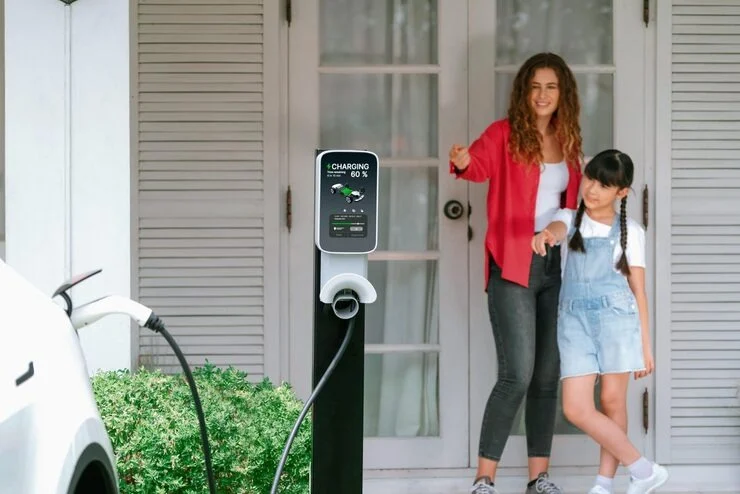There has been a massive demand for EVs, implying the need for an upgraded EV charging infrastructure. Without the right charging facilities, an EV owner can face the challenge of charging an EV wherever required. As a landlord, if you are keen on providing all the basic amenities to your tenants, then you must do so fairly and legally.
Want to learn how do you charge tenants for EV Charging? Secondly, how do you bill guests who want to charge their EVs at your rental? This tutorial will look into setting up the EV charging stations, the legalities involved, and how to set up a fair and transparent billing system.

Landlords should first understand the Cost of EV Charging.
Before moving on to what the basis of determinations on how to charge for EV charging is, we should try to understand what goes into the cost of providing the service. The cost would vary on account of several reasons, dependent on installation, maintenance of such EV charging stations, and the electricity bill:
1. Installation and Maintenance of Charging Stations
A first cost a landlord must bear will be during the installation of EV charging stations. These costs may vary according to the types of chargers you install:
Level 1 Chargers: The least expensive installation would be for owners using their very own chargers through an outlet. However, the Level 1 charger would be less attractive to tenants because it charges EVs more slowly.
Level 2 Chargers: The installation of Level 2 chargers is far more involved, including putting in a dedicated circuit and possibly upgrading the electrical panel. They’re also much better and faster chargers than Level 1 and are preferable to most tenants who intend to charge their EVs daily.
The second concern is maintenance, which could be just dusting a few cobwebs and fixing a brush here or there, or it could cover monitoring systems or subscription fees from charging networks like Tesla Supercharger Network or ChargePoint. Make sure you take all of those maintenance costs into consideration when determining what to charge for EV charging.
2. The Electricity Cost
The main ongoing cost to provide EV charging would be the electricity consumed by a tenant or guest while using the charging station. Depending on the battery size and needed charge, almost always charging an electric vehicle will require between 10 and 40 kWh of energy. In the US, the price of electricity averages about $0.13 per kWh, though it varies drastically from state to state.
In our example of a tenant charging 30 kWh, it will cost you about $3.90. Then, of course, you will have to consider if demand charges do apply since your electricity provider does have a higher rate or if demand is at peak in these hours.
How Do I Charge Tenants for Charging EVs?
That means setting up a just and transparent way for tenants to pay for charging EVs using electricity. Here are a few common bills:
1. Submetering: Most Accurate
The most straightforward and accurate way to bill a tenant is through submetering. Submetering involves installing a separate meter that measures precisely the electricity usage of the EV charging station. This allows the landlord to track how much electricity each tenant uses to charge their own EV and bill the tenant accordingly.
Pros
- Accurate: tenants pay for the electricity they use
- Transparent: tenants can see exactly what they are being charged for
- The landlord can bill tenants directly at a fair rate without any markup.
Cons
- Very high installation costs as another electric meter has to arrive to be installed.
- Need to work with the utility company in installing the meter and having to adhere to the regulations of the local jurisdiction.
2. Flat Rate Charging
Another way to bill would be for the installer to charge any EV car owner a single monthly or hourly flat fee, regardless of actual electricity consumption under this system. It is suggested that such flat rates be decided based on the average consumption of a typical EV charging.
Advantages
- Simple to explain to landlords and tenants alike.
- No meters have to be installed.
- It is fairly predictable for tenants since they know their flat fee in advance.
Cons
- Not fair for tenants who use more or less electricity than others.
- They might be short-changing or overcharging tenants, depending on whether they are providing each other’s services.
3. Pay Per Use Billing
Under pay-per-use, tenants pay for each charge according to energy consumption. Such charge provisions could be done with the help of charging stations, which comprise their billing system that includes smart charging stations connected to the network for automatic billing.
Advantages
- Charging tenants for exactly what they are using.
- The convenience of having smart chargers that automate everything.
- It encourages tenants only to charge when needed.
Disadvantages
- You will have to install smart chargers, and that initial cost will be considerably higher than a basic charge.
- Some administrative effort will be needed to set up and track this billing.
4. Rent
Some landlords prefer to pay for EV charging in their rent, particularly when there is little demand for EV charging. This would be a simple flat prepaid rate for electricity charges that includes the installation and maintenance charges.
Advantages
- Very easy to administer and coordinate.
- Tenants don’t have to track their charging costs.
Challenges
- Not so fair. Tenants who don’t use EV chargers will be helping to pay for them.
- The additional electricity charge could become quite heavy if the majority of tenants start using the chargers.

How do I Bill Guests Who Want to Charge Their EVs at My Rental Property?
If you advertise your property as a rare vacation getaway (through websites like Airbnb or Vrbo), chances are you’ll end up with guests during their stay requiring an EV charge. Charging guests for EV use can be done in various ways, depending on the rental property setup.
1. Charging as an Add-On Service
The simplest method for charging guests for using your EV charger is by putting it out as an add-on service. When advertising the rental property, you have the option of charging the guest for using the charger or making it an optional extra.
Example: “EV charging available for $10 per day of use.”
Advantages
- Easy to do.
- Flexible for guests who do not necessarily have to use the charger.
Challenges
- Requires a little bit of coordination (for example, keeping an eye on the charging station).
- Extra fees might turn some guests off, especially if they expected this to be included in the stay.
2. Charging Per Session
Your other alternative is to charge the guest for the amount of electricity used for charging during their stay, just like how tenants pay for utilities. Such types of monitoring have to be done through a smart charger or through a submeter.
Advantages
- Guests pay only for the electricity used balance.
- Simple with the right tech; i.e., smart chargers which track usage and automatically bill.
Challenges
- It may be complicated versus an organization with flat fees, perhaps requiring manual tracking or integration with a smart charging system.
- Some guests may not expect to be asked for a fee and can find it frustrating to pay extra.
3. Base Price Method
The method of charging that developers would hope encourages charges to be used voluntarily, by just charging for the actual charging. As is the usual way, you can see this in vacation properties marketed to be EV-friendly.
Advantages
- Increase guests’ willingness to book your property, as convenient charging is included.
- Guest experience with no complicated billing system
Challenges
- Negatively affecting your bottom-line profit if you have a limited number of guests who use the charger.
- If guests don’t charge their EVs, you may still be footing the bill for the electrical expenses.
Legal Considerations for Charging Tenants for EV Charging
When designing your charging system for tenants and/or guests, pay attention to the legal ramifications to avoid potential issues down the line:
State and Local Regulations: Some states are particular about how landlords may charge for utilities, including electricity. Be sure to familiarize yourselves with these laws and consult a legal professional to make sure your billing method meets requirements.
Fairness and Transparency: Whatever you choose to do, the billing has to be fair and transparent. Do not take advantage by overcharging tenants or guests for charges, and always communicate any charges up front.
Lease Agreements: Make sure lease agreements include a clause citing EV charging and the manner in which it will be billed, including the method and rates of charging.

Liability: You should be aware of the liabilities associated with the charging stations. Try to make sure the stations are installed and maintained well, so you’ve kept your chances of liability in case of possible accidents to a minimum. Also, check your insurance cover for any harm that might be caused directly or indirectly by the charging process.
Conclusion
Charging tenants for EV charging would seem really complex at first observation; however, the correct approach would surely make it transparent and fair. You submeter, set a flat rate, or charge per session, just ensure that it is fair to everyone and legal in your jurisdiction. It should be in the interest of your tenants and guests.
Because more people are now driving electric vehicles, they now want to have the option of charging for the rental property, thereby increasing its appeal to environmentally-conscious tenants and maybe another revenue stream on the side. So long as one gets the mechanics and legalities right, charging tenants for EV charging can raise profit on their livelihood.


